The Surprising—and Easy!—Way to Re-Crisp Stale Chips
Revive your favorite snack foods in less than two minutes.
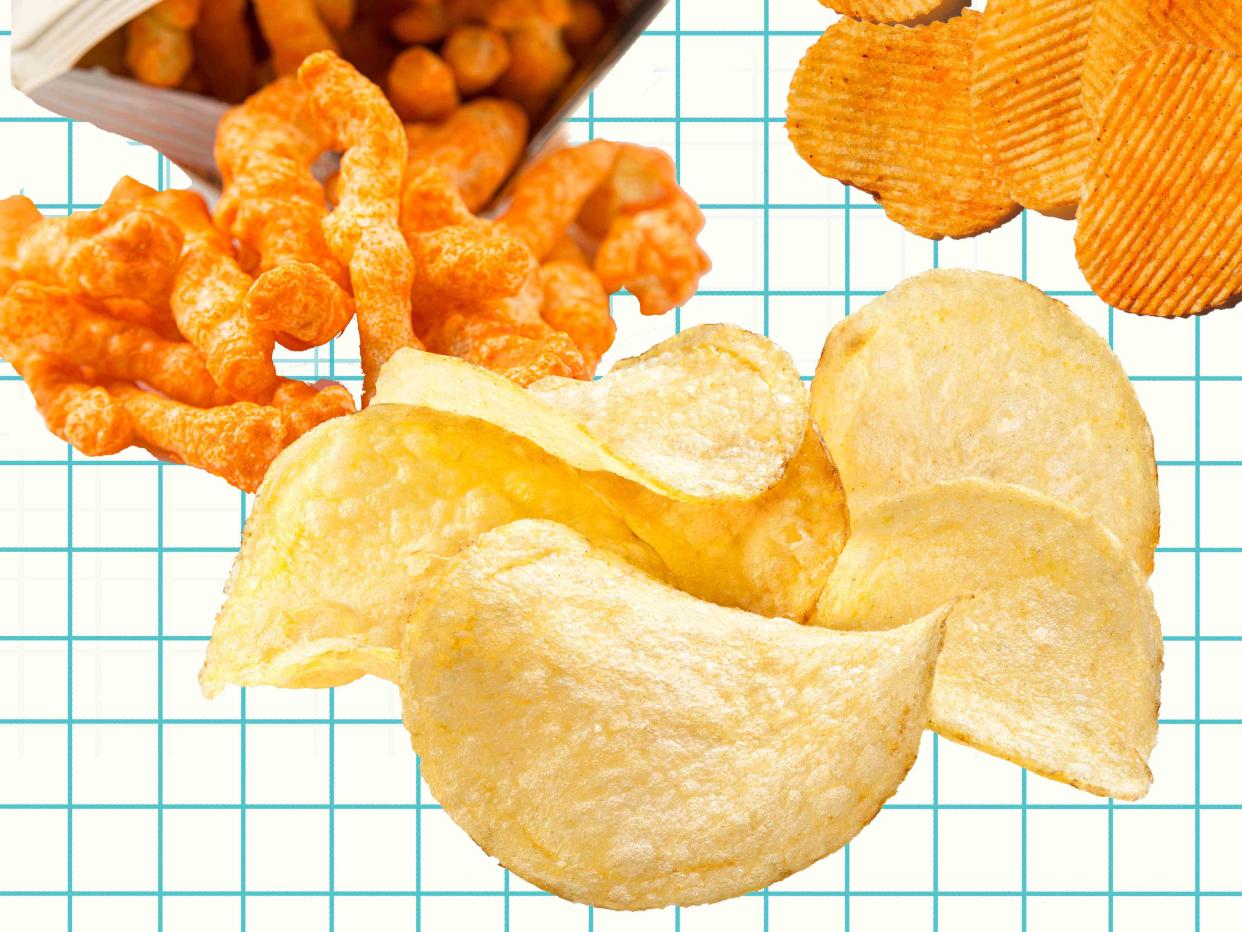
Getty Images
Imagine for a moment the joy of opening a brand new bag of potato chips: Your fingers grasp the metalized plastic, pull it apart, there's a soft rush of air, and then you reach in and grab that first crisp bite. And oh how crisp it is! Now imagine that you didn't manage to finish the bag in one sitting (we know, that part is hard to imagine). You rolled down the top, secured it with a clip, and saved it for a rainy day of Bridgerton binging. But on that fateful rainy day, you reopen the bag to find the dreaded humid chip—softened, old, utterly unwanted.
Is that it? Is there nothing to do? Of course not! I've discovered an incredibly easy way to revive chips so they’re good as new. Follow along, then prepare for a lifetime of endless crunch.
What Makes Chips Crispy?
Before we dive into how to re-crisp your chips, it helps to understand what makes food crispy in the first place. Tracking moisture content in foods, I admit, is not as exciting as watching Bridgerton. But, trust me, once you look at the numbers, they will make a lot of sense (much like Kate and Anthony—sigh!).
Raw potatoes contain a lot of water—most common potato varieties are 75 to 80% water, in fact. After frying, that number drops to about 2%, which is necessary to achieve that classic snack-food crispiness. Now, it is crucial to understand how low this number is. Even among packaged foods, this is a really low number, lower than flour (about 14%), uncooked white rice (12%), and white bread (38%).
If a potato chip's moisture level rises to just 4-5%, the perceptible reduction in crunch disappoints us. In other words, a chip that has absorbed moisture from the surrounding humidity can look completely OK and retain its salty, fried, tasty flavors, yet have a texture that’s completely different. The chips are not even remotely soggy at 4%, yet studies show consumers reject these chips for their poor texture. That tiny increase in moisture content becomes detrimental to our enjoyment of chips. Let’s look at why.
Why Is Crunchiness So Important to Optimal Snackability?
The human jaw is filled with proprioceptors, sensors that send the brain additional information about the foods we’re eating. When we’re crunching on a chip, the chewing force, the crunching sounds, and skull vibrations all add up to create a multi-sensory experience making it more enjoyable and satisfying beyond just the taste. This is why chip manufacturers spend so much effort ensuring their chips crack just right, and stay crunchy through their months-long shelf life.
We use the sound generated by food as an indication of its quality, often without even being aware we're doing so. Whether it is the crunchiness of a breakfast cereal, crispiness of a juicy apple, or the crackliness of a fried pork rind, the sound generated matters as it correlates with the qualities we seek in those foods.
There are two categories when it comes to sound generation in the foods—wet foods and dry foods. A fresh cucumber is crispy because of the intense turgidity exerted by the water inside against the cell walls. When you bite into it, you tear into the cell walls causing the turgor pressure to suddenly release. Alternatively, with dry foods like chips and crackers, they are crispy because of air cells surrounded by brittle walls. Biting into these foods break these walls, generating sound waves as they fracture and crumble. The louder the sound generated, the higher the perception of crunchiness.
To prove the impact auditory cues have on our perception of food, experimental psychologist Charles Spence of Oxford University conducted a “sonic chip experiment” in 2014. He had the people in the study wear headphones while eating Pringles, and he altered the crunch sounds they heard while eating. When the crunching sounds were louder, the participants thought the chip was 15% crunchier. And this perception of crunchiness also increased their enjoyment of the chips.
Testing the Best Way to Re-Crisp Chips
So, we’ve established that chips that have lost their crunch are disappointing. The question is, can we re-crisp them? I put two different everyday appliances—the microwave and air fryer—to the test to find out. (A conventional oven can also be used, but because the air fryer is smaller, circulates air better, and preheats faster, it’s a better choice.)
To conduct this experiment, I left bags of regular potato chips, regular Cheetos, tortilla chips, and baked potato chips open until they had lost their crunch. Usually when my children do this, they hear an earful from me. However this time they were shocked at my willingness (nay, excitement) to leave the packets open. Given the humidity in Austin, where we live, they lost their crunch within a couple of days.
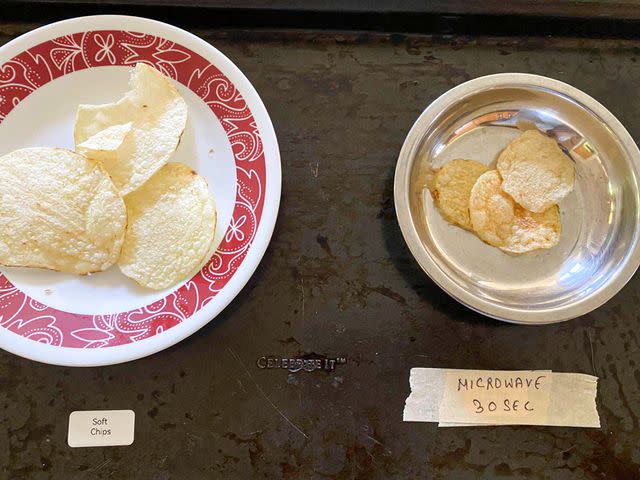
Serious Eats / Swetha Sivakumar
Option #1: Microwave
Who would not want re-crisped chips within 30 seconds? No waiting around for pre-heating. Just one dish to clean. The microwave may seem like a good option, however it does not give the best results—the chips were very unevenly crisped and developed some unfortunate hard spots.
To understand why a microwave is not great at re-crisping, it helps to know how the device works: A microwave uses the polar nature of the water molecule to make it oscillate, causing friction and heat. It relies on the water content present in the food to do the heating. As explained earlier, there is very little water in the chips, Cheetos, and other fried and baked snack foods in the first place. The microwave heats unevenly, leaving hot spots that become hard nodules that do not fracture easily when bitten. In 30 seconds, you get chips that are unevenly crispy in texture.
When I decided to extend the microwaving time to one minute, I found that more time in the microwave does not give crispier results—it just makes the snack foods unbearably hard. Cheetos, in particular, became particularly unpalatable when heated for a minute.
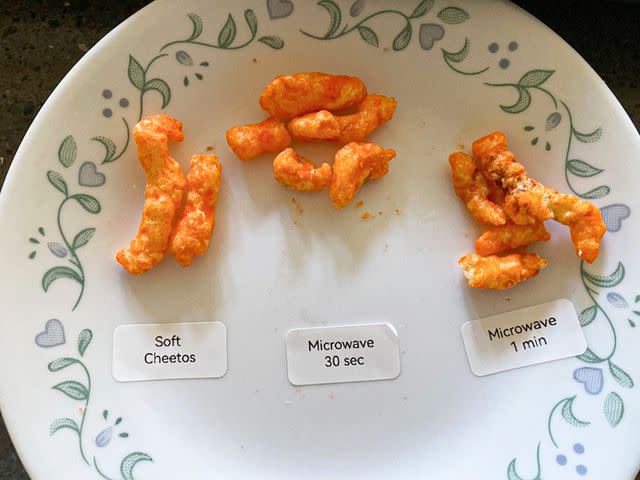
Serious Eats / Swetha Sivakumar
Option #2: Air Fryer
The air fryer turned out to be the perfect device for recrisping your chips. A basket air fryer behaves similarly to a vat of oil. They both use convection heating, except that in the case of an air fryer, the medium transferring heat is air as opposed to oil. Thanks to its fan, the air fryer is able to heat the chips uniformly.
Before reheating chips in the air fryer, it’s important to preheat the device to ensure that the moment the chips enter the basket they hit the desired temperature right away. This prevents the chips from spending any more time in the device than necessary. Use the time listed below as a guideline. Exact timings will vary based on the size and make of your air fryer. Feel free to open the air fryer every minute to check the level of crispness. Pop a chip in your mouth. Is there an audible crunch? If the snap and loudness of the crunch is perfect to you, then take it out immediately. With longer time and higher temperatures, the product undergoes browning more than what was intended with the original product.
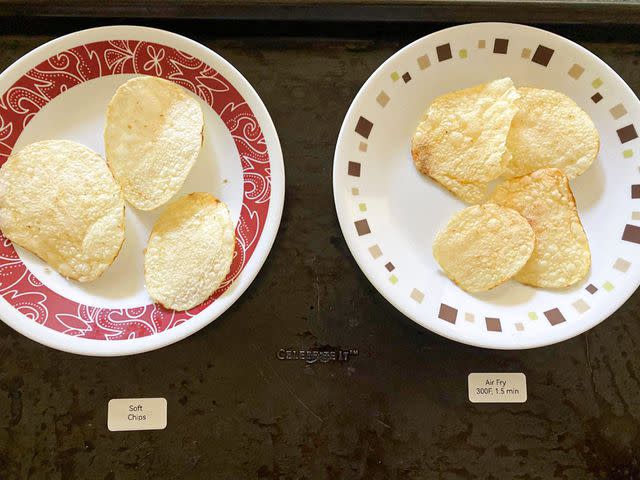
Serious Eats / Swetha Sivakumar
Cheetos, especially, are more prone to burning. This is because of the extremely fine cheese powder that envelops each treat. During the manufacture of Cheetos, the coating gets sprayed only after the corn puffs are fried.The powdery coating burns faster than a starchy potato or tortilla chip. Reheating them, therefore, has to be done with care.
Recommended Air-Fryer Settings for Perfectly Crisp Chips and Other Snacks
I used my 7 QT Gormia basket air fryer for this experiment, but any good air fryer should work similarly. I found the best air fryer temperature to be 300ºF for the regular potato chips, Cheetos, tortilla chips, and baked potato chips.
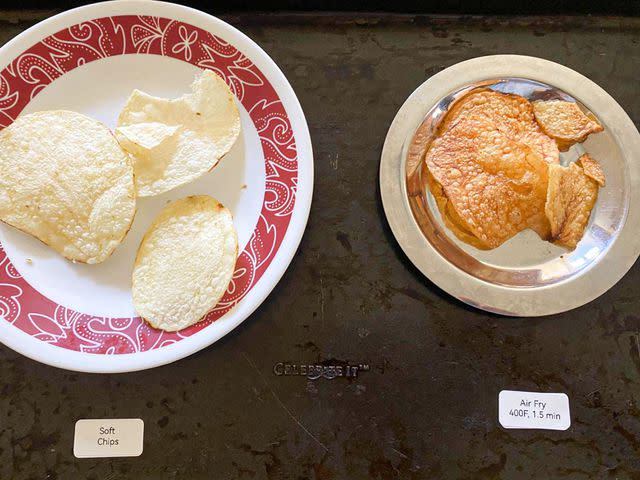
Serious Eats / Swetha Sivakumar
With increased temperature (400ºF and above) and increased time (above two and a half minutes), the food starts getting brown, changing color from the original product. If you want to stay close to the color and texture of the original product, use the lower settings mentioned above. That's 300ºF for 1.5 minutes of thin chips, and increasing from there. For thick-cut chips and other snacks, I recommend starting at 1.5 minutes and increasing the time as needed.
Thin wafer potato chips | 1.5 minutes |
Cheetos, tortilla chips, and baked chips | 2.5 minutes |
Thick-cut chips and other snacks | 1.5 minutes to start, plus additional time as needed |
More Adventures in Air-Fryer Re-Crisping
Once I figured out how easy it was to re-crisp chips, there was no stopping me. I dug out the chip bags left in the back of the pantry with all the broken pieces remaining. Into the air fryer they went and voila, they became crunchy and tasty again. The murukku packet from the Indian stores with all the broken bits at the bottom that no one wants to eat? Same results. They became crunchy and were a perfect accompaniment to my rice meal. This is such an easy way to avoid wasting perfectly good food. Plus, if you are already in love with your air fryer (like me), this will give you a new level of appreciation for this device.
Now you can only do this with chips that have lost their crunch, not rancid chips. If your chips get oxidized due to exposure to oxygen, then re-crisping them will not help. The chips will get crunchy, but still smell off. Do the sniff test at the beginning to determine whether these are worth recrisping. But, if your chips are fresh and just happened to pick up some humidity from the atmosphere, don’t throw them away. Re-crisp them!
Read the original article on Serious Eats.






